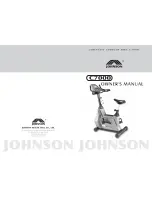
Use care “sticking” the front wheel out into a roadway, particularly when you
enter an intersection.
Rearward vision:
On a conventional bicycle, a rider can stand up on the
pedals and swivel the upper torso around to look to the rear. This swiveling
motion is more limited on a recumbent. We recommend your practice riding
include learning to both turn your head and use a rear view mirror. We have
included a rear view mirror as original equipment. Adjusted for the rider and
used properly this mirror can reduce risk but not eliminate risk.
Pedaling technique:
On the Easy Rider, you will be able to use more leg
power than on a traditional bicycle, because you can push against the seat
back, much like using a leg press machine at a gym. Be careful not to
overpower and injure your knees, particularly before your body becomes used
to the new riding position. Our advice? Use lower gears, and spin, spin, spin.
On a conventional bike you can briefly use a gear that is too high by getting out
of the saddle for a few strokes, using gravity and body weight. We often do this
after temporarily slowing the bike, or when climbing a hill. On a recumbent you
cannot get out of the saddle. Our advice? Anticipate changes in speed and
terrain, and shift to lower gears early.
On a conventional bike you will also pull against the handlebars as you push on
the pedals. On a recumbent you can push against the seat back. Learn to relax
your upper body and not to pull on the handlebars. This is the key to the
comfort and pleasure of recumbent riding. This upper body relaxation will also
minimize the small inadvertent steering corrections that often affect new
recumbent riders.
Different muscles:
The different riding position of the Easy Rider will use
different muscles and different motions. You will need to train your whole body.
As with any fitness program involving a new sport or new equipment, consult
with your doctor regarding your fitness, start slowly, work up progressively,
cross train, stretch, and listen to your body. If you feel pain, work with your
retailer on adjustments and see your doctor.
want your foot to slide off, strike or catch the ground and cause injury to your
foot or leg.
Passengers:
Do not carry any passengers, including children, on this
recumbent bicycle. The extra weight of passengers could compromise steering
or braking performance. A passenger could also compromise control.
Off-road riding:
These are not mountain bikes. The Easy Rider is similar to a
conventional hybrid in terms of off-road capability. (See section C of the
Cannondale Owners Manual) These bikes work well on roads or bike paths that
are relatively smooth and hard packed, such as cinders, good dirt roads and
“rails to trails” paths. These bikes are not intended or designed for off-road use,
such as trails, “single track” with logs, rocks, roots, or loose dirt.
Recumbents are further limited in the complex and ever changing terrain of off-
road riding because the recumbent rider has very little ability to use two
techniques that are fundamental to mountain biking: shifting weight and use of
the legs to absorb shock. For these reasons do not jump a recumbent, on or off
the road.
Recumbents also have a lightly loaded front tire that will be more likely to slide
out or slip than the tire of a conventional bicycle.
Riding in traffic: See Fig. 1
for a generalized look at your eye height relative
to a conventional bicycle and a typical passenger car. On the Easy Rider, you
may sit slightly lower than on a traditional bicycle, but still high enough to make
eye contact with automobile drivers. You will need to use caution, adapt and
practice this new position, just as you would when driving a sports car one day
and a tall four wheel
drive the next.
Note that the front
wheel of this
recumbent sticks out
further than the front
wheel of a
conventional bicycle.
You are sitting further
back on the
recumbent bicycle.
Fig. 1
Fig. 1
5
6
7































